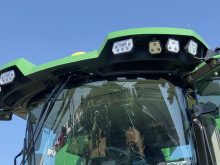.
.
.
.
.
Sprouting may be a major problem this fall in western Canadian wheat, which should provide the perfect conditions to test recent grading tech-nology.
When a kernel sprouts, enzymes are released to convert its starch into more usable food for the seedling. This loss of starch from the kernel affects the dough quality of flour milled from the sprouted grain, and can downgrade wheat to feed grade.
Read Also

Canadian Food Inspection Agency red tape changes a first step: agriculture
Farm groups say they’re happy to see action on Canada’s federal regulatory red tape, but there’s still a lot of streamlining left to be done
The baking industry measures the starch using the laboratory-based Hagberg falling number test.
Grain is ground, mixed with water, heated and stirred until a viscous paste is formed. The number of seconds it takes for the stirrer to fall through the paste is the falling number.
It’s not practical to conduct this test at grain elevators, so elevator staff determine sprouting damage by counting sprouted kernels.
New technology called rapid visco analysis (RVA) could be an alternative to the visual observation method elevators use to determine if a sample of grain will be purchased at a graded level or classed as feed.
“The (Canadian Grain Commission) had hoped we could test the effectiveness of some new technology that might take this process and move it into the (primary) elevator system,” said Dave Hatcher, head of Asian products and wheat enzymes with the commission.
“It’s time consuming for a trained grain grader and it’s still a subjective test …. This new technology makes it a science based test.”
Every year some sprouted grain arrives at primary elevators and terminals. This year, forecasters expect more sprouted wheat than usual, unless weather patterns change, said Canadian Wheat Board quality control manager Lawrence Klusa.
Hatcher said buyers of the 2009-10 crop may ask for falling number analysis, and providing that with traditional lab tests will present a challenge.
“The line companies are going to be testing some of the suites (of RVA machines),” he said.
“Some third parties will be taking part and some (labs) have bought their own.”
The RVA test is performed in the elevator using electronic bench scale equipment. It can also be done in half the time it takes to conduct a traditional Hagberg falling number test.
However, the grain commission isn’t rushing to abandon visual assessments of sprouting.
Each one kilogram sample tested this fall will be split in two. One half will go to the CGC and the other will be tested locally with Newport Scientific’s new RVA equipment.
The half that ends up in the grain commission’s Winnipeg labs will be subjected to the RVA and Hagberg tests.
“We’ll have three to compare and the data will tell us if this is an effective tool for introduction to the Canadian system and will satisfy buyers,” Hatcher said.
Seven machines will be available to the elevator companies, seven of the $60,000 suites at the grain commission, one at the Canadian Wheat Board’s lab in Saskatoon and two others in private labs. All will be participating in the process.
“This isn’t going to affect any other areas of grading, as some folks might hope or fear.”
Hatcher said new technology could end arguments between farmers and grain companies about whether a delivery has too many sprouted kernels to grade higher than feed.
Klusa said blending sprouted grain is difficult for grain companies because it takes only a small amount of enzyme to have a negative effect on milled grain’s falling number.
“And we don’t want low falling number (grain) getting into port positions tying up limited terminal storage out there…. This will allow farmers to be paid for one of the same international standards that their grain is marketed on, the falling number.”














